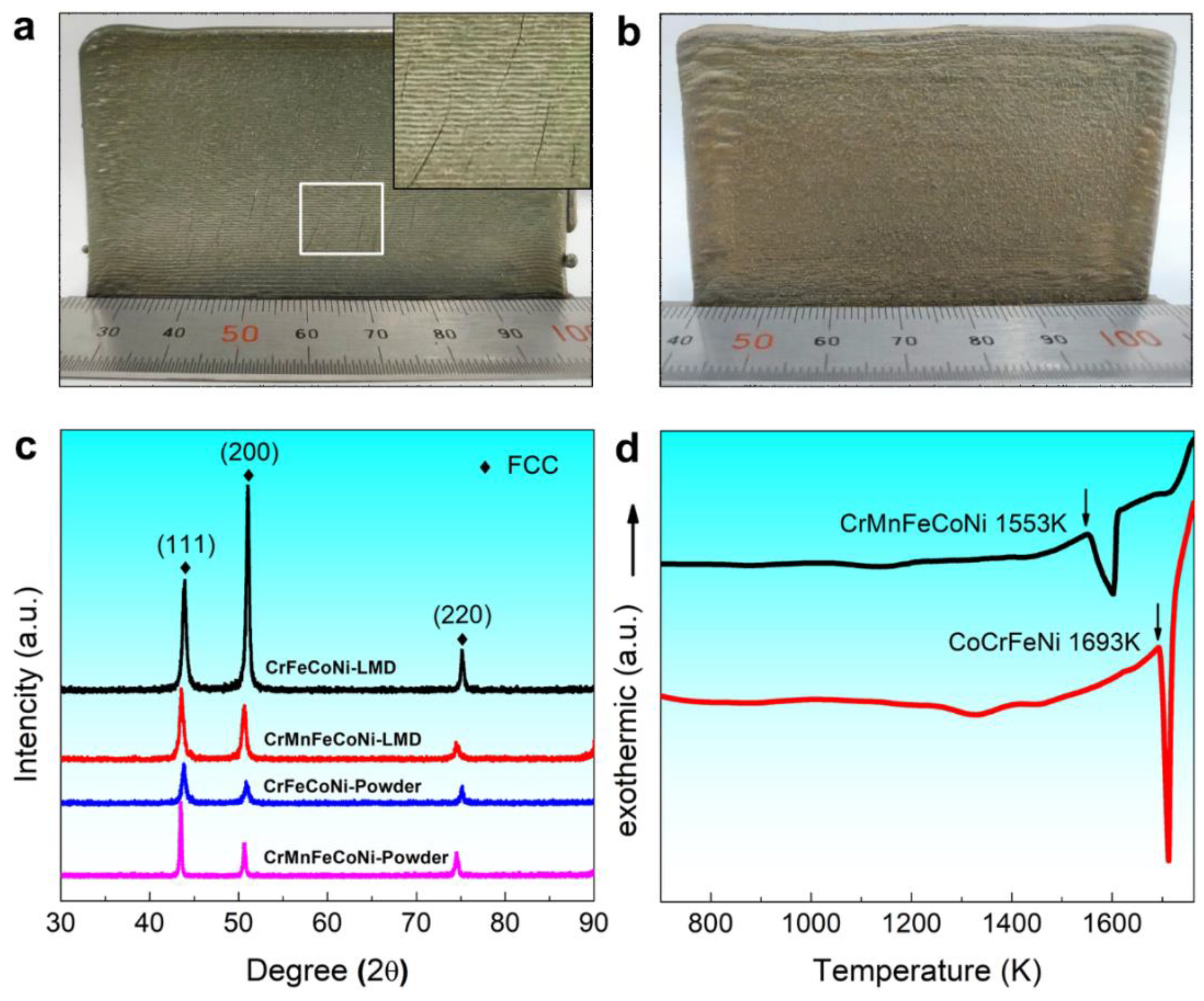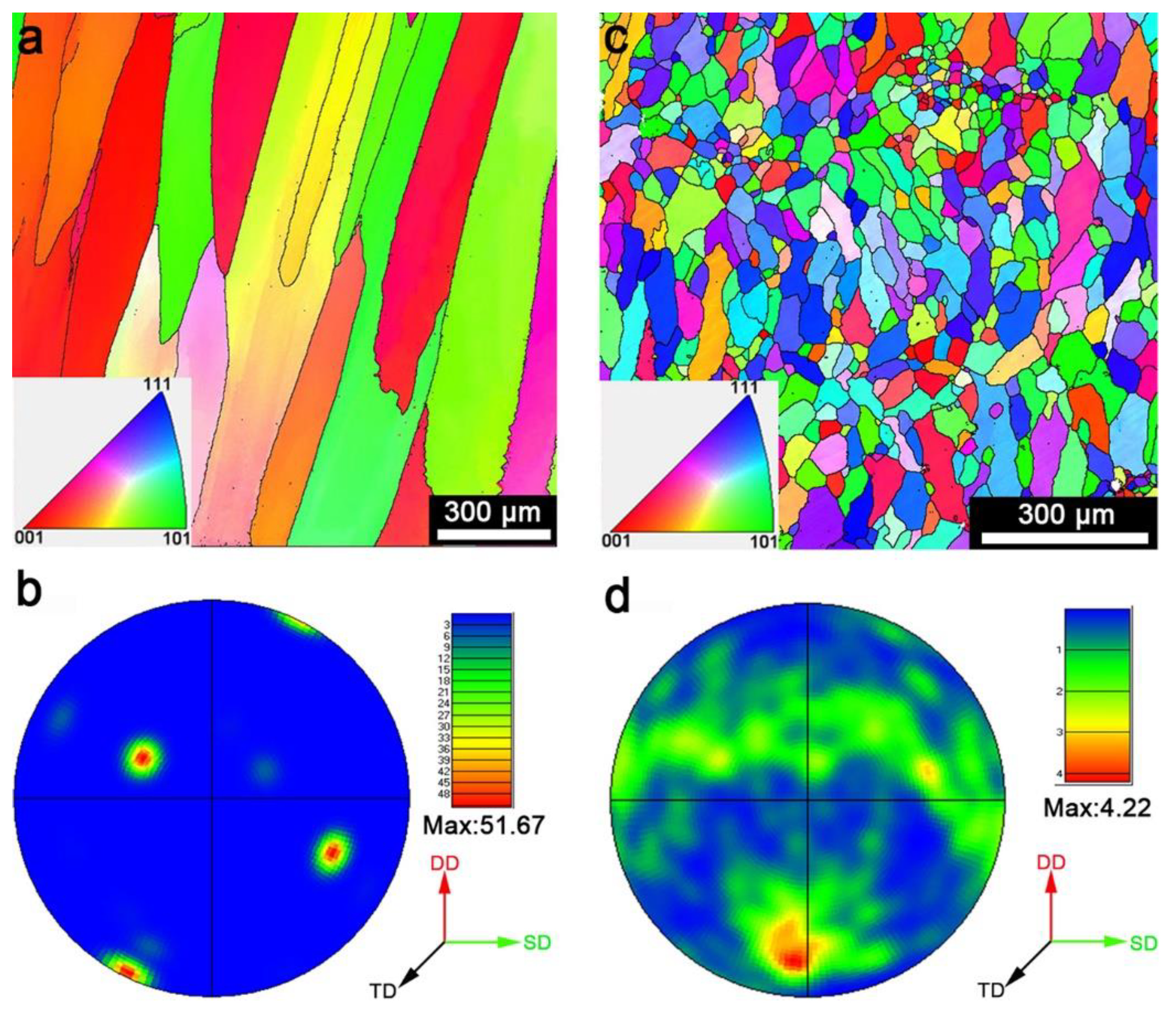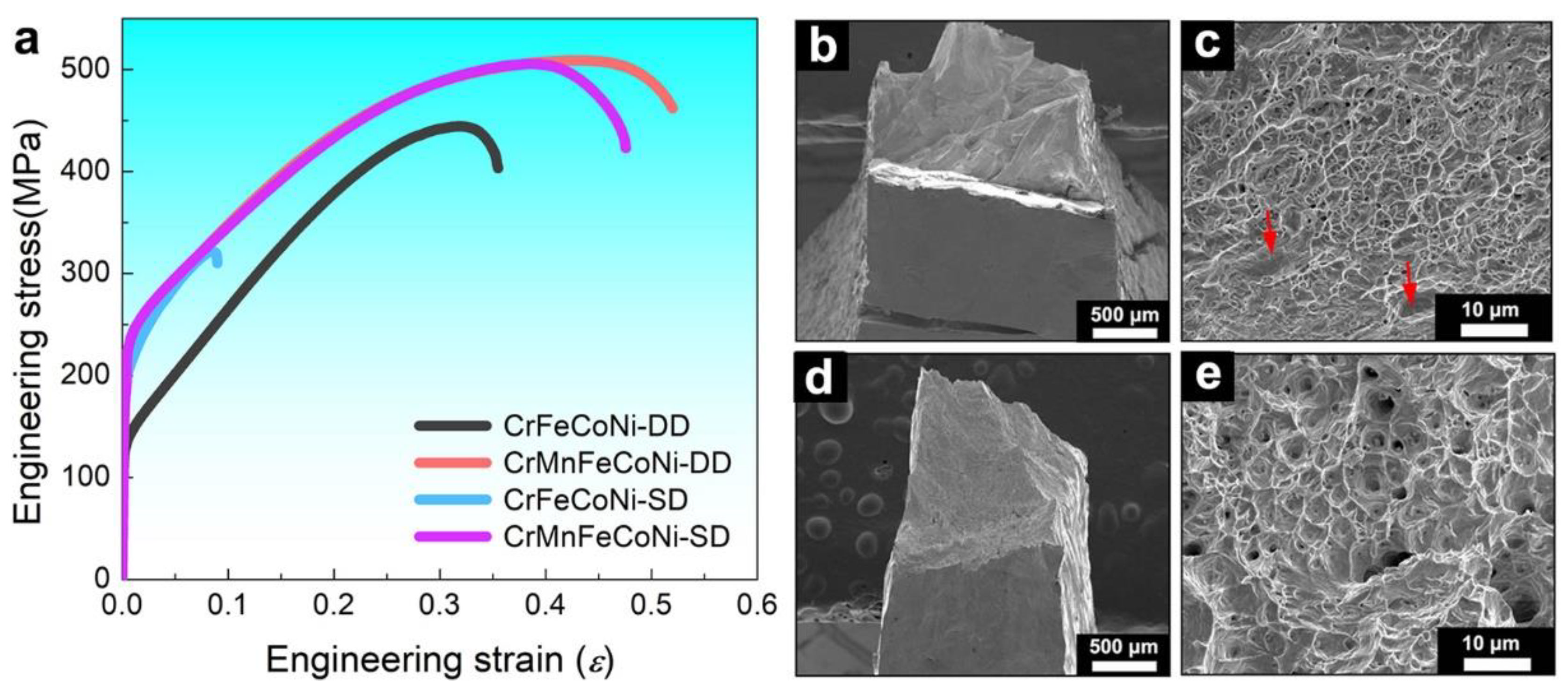A Solution to the Hot Cracking Problem and Anisotropic Mechanical Properties for Directed Energy Deposition FeCoNiCr Multi-Principal-Element Alloy
Abstract
:1. Introduction
2. Materials and Methods
3. Results and Discussion
3.1. Microstructure Characteristics
3.2. Tensile Mechanical Properties
4. Conclusions
- (1)
- With Mn addition, the microstructure of DED-fabricated CoCrFeNi transitioned from the columnar grain to the equiaxed grain.
- (2)
- The hot cracking problem and the anisotropic mechanical properties have been solved for the DED-fabricated CoCrFeNi MPEAs with Mn addition.
- (3)
- Compared with the CoCrFeNi, the yield strength, tensile strength, and tensile ductility of CrMnFeCoNi obviously improved and exhibited better isotropic mechanical properties.
- (4)
- The CET induced by controlling the compositions has been applied to resist crack propagation and improvements in AM-fabricated MPEA mechanical properties.
Author Contributions
Funding
Data Availability Statement
Conflicts of Interest
References
- Li, Q.-J.; Sheng, H.; Ma, E. Strengthening in multi-principal element alloys with local-chemical-order roughened dislocation pathways. Nat. Commun. 2019, 10, 1–11. [Google Scholar] [CrossRef]
- Long, Y.; Liang, X.; Su, K.; Peng, H.; Li, X. A fine-grained NbMoTaWVCr refractory high-entropy alloy with ultra-high strength: Microstructural evolution and mechanical properties. J. Alloys Compd. 2019, 780, 607–617. [Google Scholar] [CrossRef]
- Gali, A.; George, E. Tensile properties of high- and medium-entropy alloys. Intermetallics 2013, 39, 74–78. [Google Scholar] [CrossRef]
- Li, Z.; Zhao, S.; Ritchie, R.O.; Meyers, M.A. Mechanical properties of high-entropy alloys with emphasis on face-centered cubic alloys. Prog. Mater. Sci. 2019, 102, 296–345. [Google Scholar] [CrossRef]
- Moghaddam, A.O.; Shaburova, N.A.; Samodurova, M.N.; Abdollahzadeh, A.; Trofimov, E.A. Additive manufacturing of high entropy alloys: A practical review. J. Mater. Sci. Technol. 2021, 77, 131–162. [Google Scholar] [CrossRef]
- Chen, J.; Zhou, X.; Wang, W.; Liu, B.; Lv, Y.; Yang, W.; Xu, D.; Liu, Y. A review on fundamental of high entropy alloys with promising high–temperature properties. J. Alloys Compd. 2018, 760, 15–30. [Google Scholar] [CrossRef]
- Chen, S.; Tong, Y.; Liaw, P.K. Additive Manufacturing of High-Entropy Alloys: A Review. Entropy 2018, 20, 937. [Google Scholar] [CrossRef]
- Kim, J.; Wakai, A.; Moridi, A. Materials and manufacturing renaissance: Additive manufacturing of high-entropy alloys. J. Mater. Res. 2020, 35, 1963–1983. [Google Scholar] [CrossRef]
- Amar, A.; Li, J.; Xiang, S.; Liu, X.; Zhou, Y.; Le, G.; Wang, X.; Qu, F.; Ma, S.; Dong, W.; et al. Additive manufacturing of high-strength CrMnFeCoNi-based High Entropy Alloys with TiC addition. Intermetallics 2019, 109, 162–166. [Google Scholar] [CrossRef]
- Wang, Q.; Amar, A.; Jiang, C.; Luan, H.; Zhao, S.; Zhang, H.; Le, G.; Liu, X.; Wang, X.; Yang, X.; et al. CoCrFeNiMo0.2 high entropy alloy by laser melting deposition: Prospective material for low temperature and corrosion resistant applications. Intermetallics 2020, 119, 106727. [Google Scholar] [CrossRef]
- Chadwick, A.F.; Voorhees, P.W. The development of grain structure during additive manufacturing. Acta Mater. 2021, 211, 116862. [Google Scholar] [CrossRef]
- Tang, Y.T.; Panwisawas, C.; Ghoussoub, J.N.; Gong, Y.; Clark, J.W.G.; Nemeth, A.A.N.; McCartney, D.G.; Reed, R.C. Alloys-by-design: Application to new superalloys for additive manufacturing. Acta Mater. 2021, 202, 417–436. [Google Scholar] [CrossRef]
- Tseng, J.C.; Huang, W.C.; Chang, W.; Jeromin, A.; Keller, T.F.; Shen, J.; Chuang, A.C.; Wang, C.C.; Lin, B.H.; Amalia, L.; et al. Deformations of Ti-6Al-4V additive-manufacturing-induced isotropic and anisotropic co-lumnar structures: In situ measurements and underlying mechanisms. Addit. Manuf. 2020, 35, 101322. [Google Scholar]
- Aucott, L.; Dong, H.; Mirihanage, W.; Atwood, R.; Kidess, A.; Gao, S.; Wen, S.; Marsden, J.; Feng, S.; Tong, M.; et al. Revealing internal flow be-haviour in arc welding and additive manufacturing of metals. Nat. Commun. 2018, 9, 1–7. [Google Scholar] [CrossRef]
- Kenel, C.; Casati, N.P.M.; Dunand, D.C. 3D ink-extrusion additive manufacturing of CoCrFeNi high-entropy alloy micro-lattices. Nat. Commun. 2019, 10, 1–8. [Google Scholar]
- Pu, Z.; Du, D.; Wang, K.; Liu, G.; Zhang, D.; Wang, X.; Chang, B. Microstructure, phase transformation behavior and tensile superelasticity of NiTi shape memory alloys fabricated by the wire-based vacuum additive manufacturing. Mater. Sci. Eng. A 2021, 812, 141077. [Google Scholar] [CrossRef]
- Zhang, C.; Li, Y.; Gao, M.; Zeng, X. Wire arc additive manufacturing of Al-6Mg alloy using variable polarity cold metal transfer arc as power source. Mater. Sci. Eng. A 2018, 711, 415–423. [Google Scholar] [CrossRef]
- Kluczynski, J.; Sniezek, L.; Grzelak, K.; Torzewski, J.; Szachogluchowicz, I.; Wachowski, M.; Luszczek, J. Crack growth behavior of additively manufactured 316L steel-influence of build orientation and heat treatment. Materials 2020, 13, 3259. [Google Scholar] [CrossRef] [PubMed]
- Lee, Y.; Kirka, M.; Ferguson, J.; Paquit, V. Correlations of cracking with scan strategy and build geometry in electron beam powder bed additive manufacturing. Addit. Manuf. 2020, 32, 101031. [Google Scholar] [CrossRef]
- Liu, D.-R.; Wang, S.; Yan, W. Grain structure evolution in transition-mode melting in direct energy deposition. Mater. Des. 2020, 194, 108919. [Google Scholar] [CrossRef]
- Wang, J.; Lin, X.; Wang, J.; Yang, H.; Zhou, Y.; Wang, C.; Li, Q.; Huang, W. Grain morphology evolution and texture char-acterization of wire and arc additive manufactured Ti-6Al-4V. J. Alloys Compd. 2018, 768, 97–113. [Google Scholar] [CrossRef]
- Bermingham, M.; St John, D.; Krynen, J.; Tedman-Jones, S.; Dargusch, M. Promoting the columnar to equiaxed transition and grain refinement of titanium alloys during additive manufacturing. Acta Mater. 2019, 168, 261–274. [Google Scholar] [CrossRef]
- Liu, P.; Wang, Z.; Xiao, Y.; Horstemeyer, M.F.; Cui, X.; Chen, L. Insight into the mechanisms of columnar to equiaxed grain transition during metallic additive manufacturing. Addit. Manuf. 2019, 26, 22–29. [Google Scholar] [CrossRef]
- Tedman-Jones, S.; McDonald, S.; Bermingham, M.; StJohn, D.; Dargusch, M. A new approach to nuclei identification and grain refinement in titanium alloys. J. Alloys Compd. 2019, 794, 268–284. [Google Scholar] [CrossRef]
- Wu, Y.; Zhang, S.; Cheng, X.; Wang, H. Investigation on solid-state phase transformation in a Ti-47Al-2Cr-2V alloy due to thermal cycling during laser additive manufacturing process. J. Alloys Compd. 2019, 799, 325–333. [Google Scholar] [CrossRef]
- Zhou, K.; Li, J.; Wu, Q.; Zhang, Z.; Wang, Z.; Wang, J. Remelting induced fully-equiaxed microstructures with anomalous eutectics in the additive manufactured Ni32Co30Cr10Fe10Al18 eutectic high-entropy alloy. Scr. Mater. 2021, 201, 113952. [Google Scholar] [CrossRef]
- Xiang, S.; Li, J.; Luan, H.; Amar, A.; Lu, S.; Li, K.; Zhang, L.; Liu, X.; Le, G.; Wang, X.; et al. Effects of process parameters on microstructures and tensile properties of laser melting deposited CrMnFeCoNi high entropy alloys. Mater. Sci. Eng. A 2019, 743, 412–417. [Google Scholar] [CrossRef]
- Basak, A.; Das, S. Epitaxy and Microstructure Evolution in Metal Additive Manufacturing. Annu. Rev. Mater. Sci. 2016, 46, 125–149. [Google Scholar] [CrossRef]
- Grong, O.; Shercliff, H. Microstructural modelling in metals processing. Prog. Mater. Sci. 2002, 47, 163–282. [Google Scholar] [CrossRef]
- Zhang, H.; Pan, Y.; He, Y.-Z.; Wu, J.; Yue, T.M.; Guo, S. Application Prospects and Microstructural Features in Laser-Induced Rapidly Solidified High-Entropy Alloys. JOM 2014, 66, 2057–2066. [Google Scholar] [CrossRef]
- Han, Q.; Gu, Y.; Setchi, R.; Lacan, F.; Johnston, R.; Evans, S.L.; Yang, S. Additive manufacturing of high-strength crack-free Ni-based Hastelloy X superalloy. Addit. Manuf. 2019, 30, 100919. [Google Scholar] [CrossRef]
- Laurent-Brocq, M.; Akhatova, A.; Perrière, L.; Chebini, S.; Sauvage, X.; Leroy, E.; Champion, Y. Insights into the phase diagram of the CrMnFeCoNi high entropy alloy. Acta Mater. 2015, 88, 355–365. [Google Scholar] [CrossRef]
- DebRoy, T.; Wei, H.L.; Zuback, J.S.; Mukherjee, T.; Elmer, J.W.; Milewski, J.O.; Beese, A.M.; Wilson-Heid, A.; De, A.; Zhang, W. Additive manufacturing of metallic components—Process, structure and properties. Prog. Mater. Sci. 2018, 92, 112–224. [Google Scholar] [CrossRef]
- Yakout, M.; Elbestawi, M.; Veldhuis, S.C. Density and mechanical properties in selective laser melting of Invar 36 and stainless steel 316L. J. Mater. Process. Technol. 2019, 266, 397–420. [Google Scholar] [CrossRef]




| Element/wt.% | Co | Cr | Fe | Ni | Mn |
|---|---|---|---|---|---|
| CoCrFeNi | 27.06 | 22.24 | 25.49 | 25.21 | − |
| CrMnFeCoNi | 22.58 | 17.92 | 19.94 | 20.28 | 19.28 |
| Materials | Direction | Yield Strength σ0.2 (MPa) | Tensile Strength σmax (MPa) |
|---|---|---|---|
| CrFeCoNi | DD | 162 ± 8 | 444 ± 22 |
| − | SD | 241 ± 13 | 321 ± 18 |
| CrMnFeCoNi | DD | 255 ± 11 | 509 ± 26 |
| − | SD | 259 ± 9 | 505 ± 23 |
Publisher’s Note: MDPI stays neutral with regard to jurisdictional claims in published maps and institutional affiliations. |
© 2022 by the authors. Licensee MDPI, Basel, Switzerland. This article is an open access article distributed under the terms and conditions of the Creative Commons Attribution (CC BY) license (https://creativecommons.org/licenses/by/4.0/).
Share and Cite
Huang, L.; Li, R.; Sun, Y.; Guan, D.; Liang, C.; Jiang, C.; Chen, J.; Wang, D.; Li, J. A Solution to the Hot Cracking Problem and Anisotropic Mechanical Properties for Directed Energy Deposition FeCoNiCr Multi-Principal-Element Alloy. Metals 2022, 12, 1581. https://doi.org/10.3390/met12101581
Huang L, Li R, Sun Y, Guan D, Liang C, Jiang C, Chen J, Wang D, Li J. A Solution to the Hot Cracking Problem and Anisotropic Mechanical Properties for Directed Energy Deposition FeCoNiCr Multi-Principal-Element Alloy. Metals. 2022; 12(10):1581. https://doi.org/10.3390/met12101581
Chicago/Turabian StyleHuang, Liufei, Rui Li, Yaoning Sun, Denggao Guan, Chuanhui Liang, Chunli Jiang, Jun Chen, Dou Wang, and Jinfeng Li. 2022. "A Solution to the Hot Cracking Problem and Anisotropic Mechanical Properties for Directed Energy Deposition FeCoNiCr Multi-Principal-Element Alloy" Metals 12, no. 10: 1581. https://doi.org/10.3390/met12101581
APA StyleHuang, L., Li, R., Sun, Y., Guan, D., Liang, C., Jiang, C., Chen, J., Wang, D., & Li, J. (2022). A Solution to the Hot Cracking Problem and Anisotropic Mechanical Properties for Directed Energy Deposition FeCoNiCr Multi-Principal-Element Alloy. Metals, 12(10), 1581. https://doi.org/10.3390/met12101581






